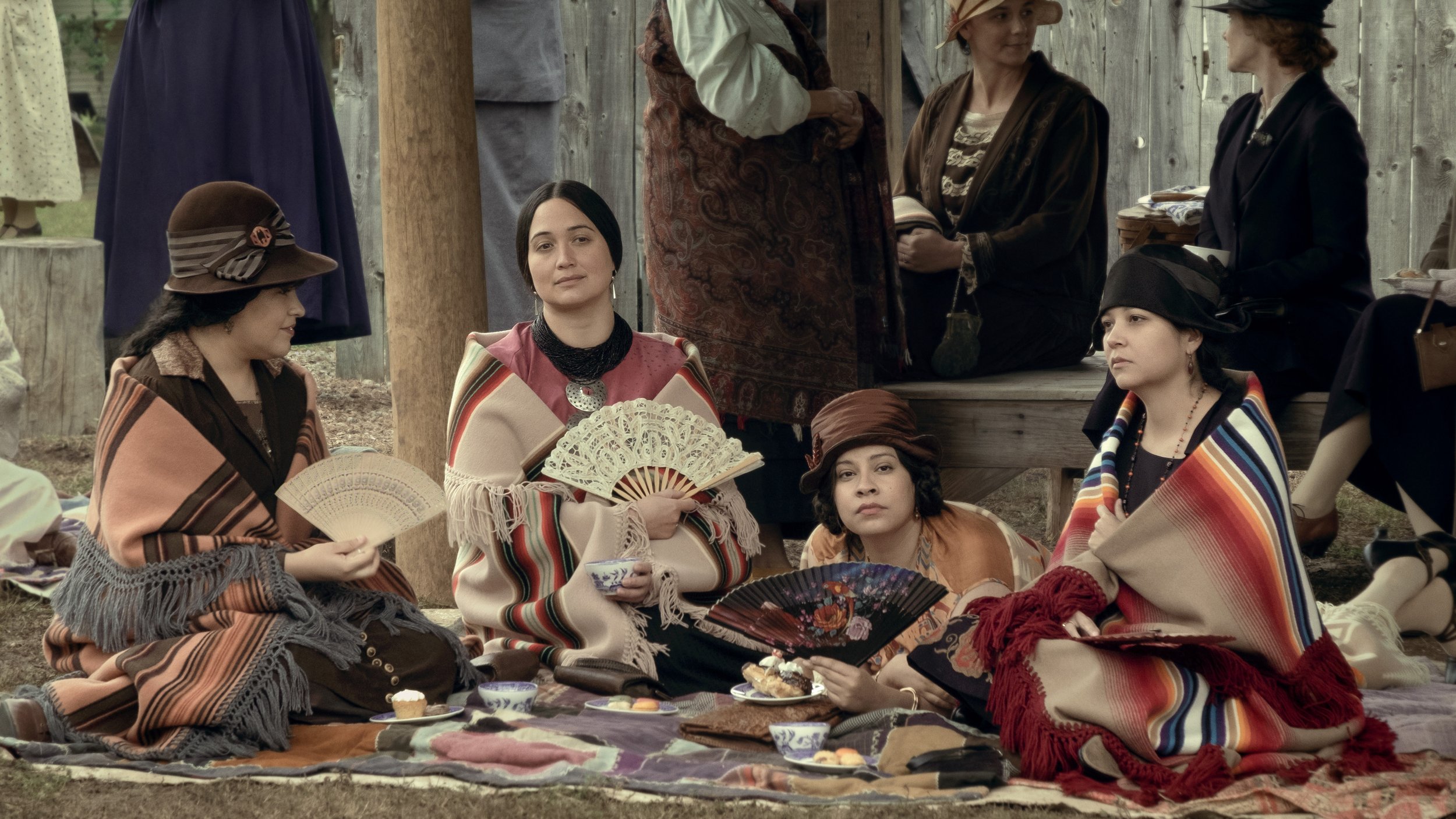Vox Populi
A curated webspace for Poetry, Politics, and Nature. Over 20,000 daily subscribers, 7,000 archived posts, 73 million hits and 5 million visitors.
Tina Kakadelis: “Killers of the Flower Moon” – Film Review
This piece was written during the 2023 SAG-AFTRA strike. Without the labor of the actors currently on strike, Killers of the Flower Moon wouldn’t exist.
American history is filled with greedy people committing heinous crimes to protect their way of life. It’s a tale as old as time and it continues into the present. As such, there’s a deep fascination in society about the depth of evil that people can hold within themselves. Perhaps that comes from the fact that we’re all human. We have a morbid curiosity about how someone who has the same genetic make-up as us could carry out such horrific acts. We see it in the current true-crime obsession that’s sweeping the podcast airwaves, streaming services, and now the silver screen, with Martin Scorsese’s Killers of the Flower Moon.
By no stretch of the imagination is Killers of the Flower Moon the first or only example of a true-crime blockbuster. The film is adapted from a 2017 book of the same name by David Grann, and it chronicles the murders of Osage people in the 1920s. In the 19th century, the United States government forcibly moved into Indian Territory (what is now known as Oklahoma). It’s on this land that oil was discovered at the turn of the twentieth century, and many Osage people became wealthy. This influx of money led to what is called the Reign of Terror, where a cattleman, William “King” Hale (Robert DeNiro), orchestrated a murder plot to gain access to the oil rights of the Osage Tribe. Ernest Burkhart (Leonardo DiCaprio), William’s nephew, was a key conspirator and married Mollie Brown (Lily Gladstone), a wealthy Osage woman with oil connections.

While Killers of the Flower Moon may be the story of the Osage murders, the film is not made for them. Scorsese’s career is built on mob movies that examine the dark underbelly of American greed. That’s his bread and butter, a theme he continues to return to in his films. He’s certainly made some of the finest movies in that genre (GoodFellas is a personal favorite of mine). There are plenty of other stories, both fictitious and factual, that Scorsese could have chosen if he wanted to focus on greed and the way violence is intrinsically woven into the DNA of the United States. To choose to tell the story of the Osage people without having Mollie or one of her siblings as the main character feels like an utter disservice to the realities of what they, and many other tribes, continue to experience.
It’s a sad fact of Hollywood that Native filmmakers are not being given large checks from studios to tell their stories. The same is true for any minority filmmaker. It’s unlikely that Scorsese’s version of Killers of the Flower Moon is the same story that a Native director would tell, and Scorsese’s version is not what I wanted from this film. It’s not something novel to see white men in positions of power exploiting people for their own personal financial gain. You can see that any time you turn on the news or revisit one of Scorsese’s past works. The perspective of Mollie, her family, and her community is much harder to find. Even though Scorsese was in constant contact with members of the Osage nation, this was not a film from their perspective.

It’s clear that Scorsese put effort into learning about the Osage and making sure the costumes and dialogue were accurate, but Killers of the Flower Moon is the story of DeNiro and DiCaprio’s White characters. Gladstone is a phenomenal actor whose talents are scarcely used, and Kelly Reichardt films like Certain Women and First Cow are far better uses of Gladstone’s abilities. While DeNiro utterly shines as the evil mastermind King, DiCaprio is lackluster and awkwardly emotive in a way that feels contrived. All of the characters were underdeveloped, which is strange considering the staggering three-and-a-half-hour runtime. The audience leaves the theater without learning much about the Osage murders other than their brutality. There was time to show the escalation of tension, but the film’s structure implies that the Osage people were passive observers of the loss of their community members — as though their story pales in comparison to the corruption that’s taking place.
The film ends with a radio play as a means of summarizing the court cases of King and Ernest. The scene works as a replacement for the usual bland title cards that come at the end of movies based on true stories and as a small critique on society’s contemporary obsession with true crime. That criticism would’ve hit harder if the film hadn’t fallen into the trap of what it was critiquing. By taking the focus away from the victims, Killers of the Flower Moon is no better than a true-crime podcast leaning into the scandalous side of things instead of providing meaningful reflection and insight from the people who experienced such immense, terrible loss.
Tina Kakadelis is a writer who’s seen a lot of movies. Follow her on Twitter, Instagram, Letterboxd, and YouTube.
Copyright 2023 Tina Kakadelis. Included in Vox Populi with permission. Photos from Apple TV.

Martin Scorsese is a wise choice to direct any film. He is a master of the art. If you think this story was told only from the perspective of white men, I invite you to watch again and rethink the notion.
LikeLike
If Kakadelis has seen as many movies as she intimates she has, then she’d know that true crime as a genre in film goes back nearly to the movies inception. (They were making mob films in the 20’s for example.) Her problem is that she’s reviewing a film that she made in her mind, not the one spooling out onscreen, and naturally she’s disappointed. She is right that Scorsese was not a good choice to direct this film. (He thinks of it as a Western and, initially, he’d planned to focus on the FBI’s investigation of the murders. It was DiCaprio who steered him into focusing on the Osage.) Racial authenticity is not a precursor for aesthetic success, however. Spike Lee did a mediocre job with Malcolm X, for example. Scorsese is not a director interested in politics or race. And that is what the Reign of Terror was about: an entire white community’s conspiracy to plunder the Native Americans they had control over. And Scorsese only glancingly touches on that. That being said, she’s also wrong about the performances. Gladstone’s character has some of the strongest scenes in the film, (there are also several powerful scenes with the tribal elders) while DeNiro is long past his sell-by date as an actor. (He’s just making scary faces now.) And DiCaprio bizarrely morphs into Billy Bob Thornton in Sling Blade during the last hour. Finally, it’s C- film, sporadically interesting in telling an important story.
LikeLike
What irritates me about most movie reviews in general is that the reviewer ( speaking of so called “professionals”) may spend most of their time writing of how the movie compares to the source of the story and how the directing compares to the directors previous work or how the actors performances compare to their other work. They seem only to want to brag about their extensive knowledge of the movie industry.
It seems to me, each film should be viewed and critiqued as if the performers where previously unknown, the director is not known, the source material is unknown, and completely devoid of historical comparisons. Does the story and the performances intrigue? How’s the lighting, the photography? Is there a thump in the chest, a tear, a profanity elicited? It doesn’t matter to me if this was the leading actors 3rd best performance or if the original story line was diluted or enhanced or if history was changed. Wow! I feel better.
LikeLiked by 1 person
thanks, Leo!
LikeLiked by 1 person
“”””but Killers of the Flower Moon is the story of DeNiro and DiCaprio’s White characters…” Agree, this film was a major disappointment. Not only is this review accurate in every way, but I was disappointed in the acting overall. In addition, Scorsese could easily have chopped at least 45 minutes away from the film without losing anything of relevance. Just a second rate movie all the way around.
LikeLiked by 1 person
So Kakadelis has seen a lot of movies? In the last 3 or 4 years, maybe? If she had any real knowledge, she’d know that true crime has been a constant since film’s inception. (Hollywood was making gangster movies in the silent film era, for example.) But with Killers…she’s made the usual lame critic’s mistake: she’s critiquing the movie SHE wanted to see rather than what was presented in the theater. And that will always lead to disappointment. That being said, Scorsese was probably not the best person to make this film. (He considers it a Western, for example, and initially had planned to focus on the FBI’s pursuit of the criminals. It was only DiCaprio’s intercession that turned it toward the Osage.) The real focus should have been the ENTIRE community’s corrupt and racist conspiracy to fleece the Osage. And, except in a very few scenes, that’s barely touched on. In the film and in reality, the Osage are not passive so much as handcuffed by the Federal government’s dismissal of their concerns and the duplicity of their local white minders. As to the performances, Gladstone has many of the most powerful scenes while DeNiro, who’s past his sell-by date as an actor, mostly makes scary faces. And DiCaprio, while generally interesting, for some bizarre reason in the last hour, lapses into an impersonation of Billy Bob Thornton in Sling Blade. I give Killers… a B-, C+ overall.
LikeLike